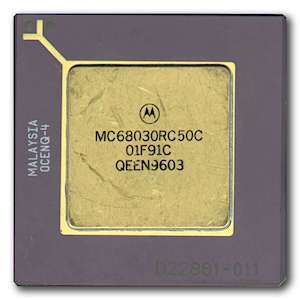SE/30 Forever
< Back to homeProcessor

The SE/30 uses a Motorola 68030 CPU operating at 16 Megahertz (MHz). This was a 32-bit processor first released in 1987 as the successor to the 68020. Its successor, the 68040, was not released until 1990, a year after the SE/30 was released.
The CPU executes programs stored in RAM and ROM, performing calculations, accessing hardware devices, and transferring data to and from memory and I/O devices. Device selection, RAM control, and some other functions-such as control of the video and sound circuits in the Macintosh SE-are handled by general logic circuits. (The PALs, BBU, and GLUE ICs are examples of general logic circuits.) The VIAs, SCSI, IWM, SWIM, ASC, and SCC ICs provide interfaces with I/O devices.[1]
It does not have a built-in FPU, this functionality is served by a separate Math co-processor, the Motorola 68882.
The 68030 uses a 128 pin PGA (pin grid array). In the early production run of the SE/30, the logic board used a socket for the processor. Later versions were soldered to the board.
The 68030 increases performance by ≈5% while reducing power draw by ≈25% compared to the 68020.
Upgrading the processor in a SE/30
If your logic board is socketed, you can swap the processor for one with a higher clock speed. However, doing so will have no effect on the clock speed it actually runs at, as this is limited by other components on the logic board.
That being said, there are accelerator boards which were designed to be used with a socketed logic board and will provide improved performance. One example is Daystar's PowerCache card which has a 40MHz 68030.
The Processor Direct Slot (PDS) can be used as another upgrade path to add an accelerator card.
References
- 1. Guide to the Macintosh Family Hardware, Second Edition, Apple Computer, 1990.